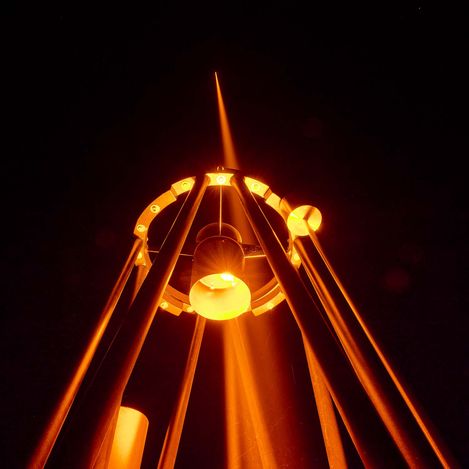New powerful laser passes field test
31-08-2021 A powerful experimental laser developed by the European Southern Observatory (ESO), TOPTICA Projects [1] and other industry partners [2] passed a key test last month at the Allgaeuer Volkssternwarte Ottobeuren observatory in Germany. The adaptive-optics laser has important additional capabilities compared to existing systems. It is to be installed at the European Space Agency’s (ESA) Optical Ground Station in Tenerife, Spain, in the frame of the ESO–ESA Research & Development collaboration. The higher laser power and its chirping system will lead to significant improvements in the sharpness of astronomical images taken with ground-based telescopes. The technology also opens the door for developments in laser satellite communication.
Astronomical adaptive optics refers to systems on ground-based telescopes that correct for the blurring effect brought about by turbulence in the Earth’s atmosphere — the same effect that causes stars seen from Earth to “twinkle”. To remove the distortions, these systems require a bright reference star close to the object of study. Because these stars are not always conveniently placed on the sky, astronomers use lasers to excite sodium atoms at 90 km altitude in the Earth's atmosphere, creating artificial stars near the field of interest that can be used to map and correct for the atmospheric turbulence.
The narrow band highest optical quality laser power of 63 Watts locked to the sodium wavelength as such is already a significant leap forward compared to current astronomy laser technology. However, a second important step has been the experimental frequency chirping system developed and implemented by TOPTICA Projects in collaboration with ESO, that is targeted to also improve the signal-to-noise of the adaptive optics system.
Chirping consists in rapidly changing the frequency to which the laser is tuned. This increases the number of sodium atoms excited by the laser, making the artificial star brighter and thus improving the turbulence correction. TOPTICA has installed the chirping prototype on the ESO 63 Watts CaNaPy laser and, together with ESO, has commissioned on sky both the laser and its novel chirping system.
Once the technology is installed at the ESA Optical Ground Station in Tenerife — a collaborative project between ESO and ESA — it will provide both organizations with opportunities to advance the use of laser guide star adaptive optics technologies not only for astronomy but also for satellite optical communication.
[1] In the frame of a collaborative ESO-TOPTICA R&D agreement for laser frequency chirping developments
[2] The other industry partners are MPB Communications for the 100W RFA and High Finesse for the wavemeter
For details please get in touch:
www.toptica.com/sodiumstar
elt.eso.org
Your contact for press inquiries:
Jan Brubacher
Senior Marketing Manager
Phone: +49 89 85837-123
E-Mail: jan.brubacher [at] toptica.com
TOPTICA Photonics AG
Lochhamer Schlag 19
82166 Graefelfing, Germany
The photos may only be used in editorial material - commercial use is not permitted. TOPTICA Photonics AG must always be named as the source. Please don't hesitate to contact me if you have any questions.

